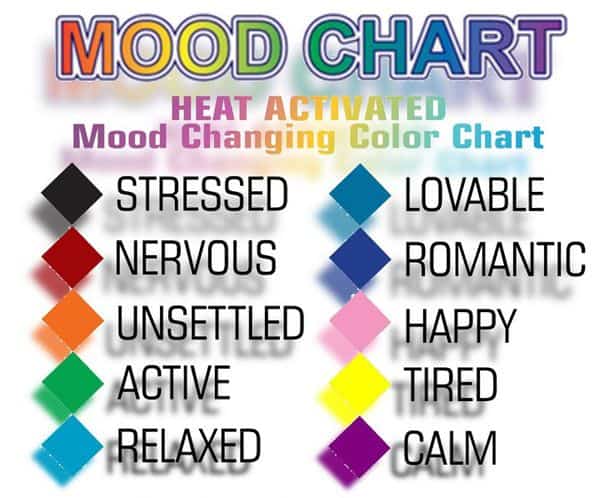Mood rings first became popular in the 1970s as a way for people to get a sense of their mood or emotional state based on the color of the ring. The rings contain thermochromic liquid crystals that respond to changes in body temperature by changing colors. Each mood ring color is associated with a different perceived emotional state or mood. When someone is tired, the decreased blood flow can cause hands and fingers to become cooler, which leads to a change in mood ring color.
Mood Ring Color Meanings
Mood rings come in a variety of colors, each linked to a different mood or emotional state:
| Black | Stressed |
| Blue | Calm |
| Green | Normal |
| Yellow | Happy |
| Brown | Nervous |
| Grey | Sad |
| Amber | Anxious |
| Violet | Passionate |
As you can see, mood ring colors cover a wide gamut of emotional states ranging from stressed to happy. When tired, people often experience decreased blood circulation which leads to a mood ring turning a color indicating a more subdued mood.
What Color Means Tired
When someone is tired, their hands and fingers become cooler due to decreased blood flow. This drop in temperature will cause mood rings to turn a color indicating a more low energy emotional state. The two most common mood ring colors representing feeling tired are blue and gray.
A blue mood ring color is associated with feeling calm and peaceful. When tired, people become more relaxed and less energetic. The cooler body temperature will trigger the mood ring to turn a shade of blue representing this calmer state of being.
Similarly, a gray mood ring color is linked to feeling sad or depressed. Fatigue can sometimes lead to mildly depressive feelings and a lowered mood. The gray color reflects these more downbeat emotions that often accompany feeling drained or tired.
So in summary, blue and gray are the two main mood ring colors representing a tired state. The next time your mood ring turns one of these cooler colors, it likely means you are feeling worn out and fatigued.
Why These Colors Indicate Feeling Tired
Mood rings change colors based on shifts in finger temperature. When tired, people experience decreased blood circulation which leads to cooler body temperatures, particularly in the extremities like hands and fingers. This physiological response triggers the thermochromic liquid crystals inside the ring to change to colors associated with being tired.
More specifically, here is why blue and gray mood ring colors are linked to feeling tired:
Blue:
– Blue represents calmness and relaxation. When tired, people become more peaceful and less energetic.
– Decreased blood flow causes hands and fingers to become cooler. This drop in temperature changes the mood ring to a calm blue.
– Fatigue leads to lowered physical arousal levels which are reflected in the tranquil blue color.
Gray:
– Gray is associated with sadness and melancholy. Tiredness can cause mild depressive feelings and a low mood.
– Cooler finger temperature due to less blood circulation alters the mood ring to a gray color.
– Low energy when tired often translates to a more downbeat emotional state, represented by the gray tone.
So both blue and gray reflect the typical mood shifts and physiological changes that occur when someone is feeling tired and run down. The cooler colors match the drained mental and physical state of fatigue and exhaustion.
How Accurate Are Mood Ring Colors?
The accuracy of mood rings in reflecting emotions has been debated. Some key considerations include:
– Mood ring color meanings are generalizations and may not capture specific emotional states.
– Other factors besides mood can impact finger temperature like environment and circulation.
– People may interpret the colors differently based on personal associations.
– Mood rings offer no quantitative measure of mood, only qualitative color indications.
– Research on mood rings is limited, so their true accuracy remains unproven.
However, mood rings do seem moderately effective at reflecting basic arousal levels and indicating general mood states like feeling tired, excited, calm, or stressed. Their accuracy at specifying complex emotions is less established. But for a simple gauge of low energy levels when tired, mood ring colors can provide reasonably insightful clues.
Tips for Accuracy
To increase mood ring accuracy at detecting tiredness, here are some tips:
– Wear the ring on bare skin for 20 minutes before assessing color.
– Keep the finger still to establish a stable temperature.
– Take off rings and avoid hand washing which can impact temperature.
– Compare color to the mood ring chart to avoid misinterpreting.
– Consider environmental factors like cold weather that could skew color.
– Combine color with how you actually feel to validate the interpretation.
– Remember mood rings offer approximations, not definitive assessments.
Following these guidelines can help enhance the precision of a mood ring in identifying when you are feeling tired or fatigued based on the representative color that appears.
Conclusion
Mood rings can provide simple visual insight into feelings of tiredness based on their color. When fatigued, decreased circulation causes hands to become cooler, shifting mood rings to colors like blue and gray that represent low energy emotional states. While not scientifically foolproof, mood ring colors give a general gauge of internal states like exhaustion. With some caveats, they offer a basic indicator of when you are feeling drained and in need of rest. So pay attention next time your mood ring turns blue or gray as it may be a helpful reflection of your tired mood and need to replenish your energy.


